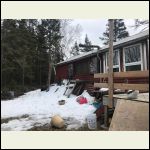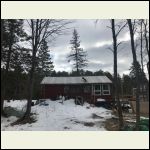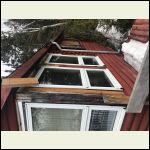|
| Author |
Message |
jregier
Member
|
# Posted: 27 Mar 2020 10:03pm
Reply
Hey all,
Newbie here, I have spent countless hours over the past few weeks reading on the forum, everything from new construction to lakewater supply. I have learned a great deal and very much appreciate this resource!
I just purchased a hunt cabin in the Whitestone (Ontario) area. The current building is 16x24 and does not look to have much of a foundation. IT is supported around the perimeter with blocks/chunks of wood directly on the ground.
I would like to build a single story addition attached to the gable end... extend the 16' width another 24'. The finished cabin would be 16'x48'. The cabin is a 5 km ATV ride through the bush... with some mud holes... so access and ease of bringing materials isn't great. I am really struggling to figure out what my best bet is for the foundation... keeping in mind the access. I am thinking of doing 20"x20" x 8" thick footings 4' down, use angle brackets to fasten 6x6 PT posts that extend 18" or so above grade. Backfill with dirt or sand if I can find it on the property. I would love to do full concrete piers but I think that will be too much concrete to haul back there... need to run the numbers on how many bags. The piers would be 8' OC.. 4 piers long by 3 piers wide. I would notch the posts and set (3) laminated 2x10's along the long sides and center for beams, 2x10 joists with hangers 16" OC. I will work on a sketch to clarify the above.
So.. my questions are:
1) Given the existing foundation looks to be NOT down below frost depth, If I put the addition foundation below frost depth and attach to the existing cabin, is there cause for concern with differential movement? If so what would you recommend?
2) Do you think the footing with PT post is an adequate foundation? If not, what would you suggest?
3) Can someone point me in the right direction on how to correct the foundation on the existing cabin? Without having to tear it down...
I am going to try and attach pictures of the existing cabin. Thanks everyone for your input!
|
|
jregier
Member
|
# Posted: 27 Mar 2020 10:06pm
Reply
Pictures
|
|
jregier
Member
|
# Posted: 27 Mar 2020 10:12pm
Reply
Pictures
IMG_4621.jpg
| 
IMG_4717.jpg
| 
IMG_4636.jpg
|  |
|
|
jregier
Member
|
# Posted: 28 Mar 2020 09:11pm
Reply
This is what I am thinking... thoughts?
|
|
Princelake
Member
|
# Posted: 29 Mar 2020 09:26am
Reply
I would not put pressure treat in the ground like that. Pressure treat is not designed to go below grade. It will rot. I'd do a footing and cinder block if you want dont want to haul in Sono tubes and cement. Or go the more expensive option and use these foundation screws https://pylex.com/en/products/10555-adjustable-pylex-50-black
I've never put an addition onto a cabin like that but I would assume to not connect them by supporting structure. I'd run the roofing,siding,etc if you attach them together the frost will move the new addition with it.
|
|
rpe
Member
|
# Posted: 29 Mar 2020 09:56am - Edited by: rpe
Reply
I assume you're in typical Canadian Shield in your area? How far down is bedrock? I'd do some probing/digging to figure that out first. There's no use putting an addition on until what you have is sitting still all year!
We did similar work to our cottage, and dug down to bedrock, poured small flat footings pinned to the rock, and then built up piers using bull-nose blocks from the Rona in Parry Sound. We are water access, so we hauled the supplies in by snowmobile when the lake is hard. Four lengths of rebar were run up through the pier blocks, and stacked and filled with concrete to create one solid support.
Afterwards, the area around the pier was backfilled with gravel to assist in drainage and keep the clay from attempting to frost-heave our hard work.
Under our cottage, bedrock ranged from above-grade, to 5 ft below grade, so pier heights varied dramatically. Since that work the cottage has been standing tall and straight, and doors open properly all year round.
Note that this work was done under an existing cottage digging by hand. Short shovels, patience, and good friends are all assets in a project like this.
|
|
Brettny
Member
|
# Posted: 29 Mar 2020 10:35am
Reply
No wood underground or close to the ground. How big are your girters and how far are the posts spaced?
|
|
jregier
Member
|
# Posted: 29 Mar 2020 04:57pm
Reply
Thanks for the reply's everyone. I will dig a few holes when I go there in a couple of weeks to see how deep bedrock sits.
The girters I have at (3) 2x10's nailed together, seams over posts and staggered. The posts are spaced at 8 feet.
|
|
|
jregier
Member
|
# Posted: 29 Mar 2020 05:12pm
Reply
The screws sound like a good option but if I hit bedrock 3 ft down I am euchred right? .. the height would be too high. How big of footings did you pour on the bedrock? If I did sonotubes on bedrock do you need footings?
|
|
ICC
Member
|
# Posted: 29 Mar 2020 05:44pm
Reply
girder, with a D, not girter, everyone.
Quoting: jregier If I did sonotubes on bedrock do you need footings
If the bedrock is solid bedrock, not just a jumble of rock the bedrock is the footing. Drill and epoxy in some rebar first and then cast the concrete around the rebar (bent hook end)
|
|
jregier
Member
|
# Posted: 29 Mar 2020 08:18pm
Reply
Got it thanks!
What size footings if I don't hit bedrock? What diameter sono tubes would you recommend?
At 20"x20"x6" footings, 10" dia. 48" tall sono tubes I am at 5700lbs (86 bags) for the 12 posts (assuming the 8ft spacing is sufficient??).
|
|
Ontario lakeside
Member
|
# Posted: 29 Mar 2020 09:04pm
Reply
Hey jregier
We built on bedrock/minimal soil with piers, triple 2x10 girders. We used 6x6 galvanized saddles grouted directly to the bedrock where exposed and on 10" sono tubes where there was soil, securing the concrete with rebar drilled into the rock. Its been about 6 years and its dead level. Best foundation ever! Check out this video it shows our process. Good luck and have fun.
https://www.youtube.com/watch?v=Mn4At5_8KJ0
|
|
Brettny
Member
|
# Posted: 30 Mar 2020 06:36am
Reply
Sono tubes down below the frost line are footings. I believe they need to be 12in and 48in below ground.
What size floor joists are you useing?
Have you contacted the municipality who's going to inspect this to see what they want?
|
|
rpe
Member
|
# Posted: 30 Mar 2020 08:17am
Reply
Just a caution here. Our cottage had sonotube piers that went down 4' or more in spots, in some cases on bedrock, and in other cases 'floating'. We have lots of wet clay soil under that side of the cottage, and the differential freeze-thaw cycles cracked and pushed those piers around to the point of near collapse. We carefully shored up the cottage with beams and jacks in the dry season, and dug out the cracked and failing piers. They were replaced with the pier block stacks I mentioned above.
For us the pier block stack had some advantages:
- much less concrete mixing to deal with, as we're just filling the block cavity
- easier to deal with under the cottage, as filling a standing sonotube under the structure could be a pain. When stacking the pier blocks, it's only awkward for the last couple blocks in the stack.
- easy to haul and stack blocks at pier locations in winter with snowmobile/cargo sleigh.
Brettny has a good point regarding inspections, or are you in an unorganized township?
|
|
jregier
Member
|
# Posted: 30 Mar 2020 08:39am
Reply
I was going to use 2x10 joists with joist hangers off the girders. That is common with the existing cabin, if I set the joists on top of the girders/beams then there would be a step up to the addition. Is there an advantage one way vs. The other?
What do you mean by grouted directly to the bedrock?
|
|
jregier
Member
|
# Posted: 30 Mar 2020 08:41am
Reply
I am being told I shouldn't reach out to the building department as they will likely make me tear the existing cabin down because it doesn't meet code and it may be too close to the shore. I'm on the fence whether to discuss with the local authority or not... I am concerned if I reach out to them then they know about the cabin and may open a can of worms. The cabin is quite far back into a bush across crown land, down private ATV trails so the likelihood of them ever finding out about an addition is slim... again this is what I am being told.
|
|
Princelake
Member
|
# Posted: 30 Mar 2020 11:49am - Edited by: Princelake
Reply
I can't see them making you tear it down. I've worked on some pretty crappy homes and the most they'll do is add to your building permit/inspection things they would like to see done and they've been very reasonable.
They do look at satellite imaging and if you give them a hard time they'll give you a hard time.
|
|
Ontario lakeside
Member
|
# Posted: 30 Mar 2020 12:16pm
Reply
After drilling the bedrock we used a cement grout to bond a 3/4" threaded rod into the hole. then a 6X6 mounting plate was bolted on or a concrete pier was cast around it to get above ground level. in our case the tallest pier was 24"
|
|
spencerin
Member
|
# Posted: 30 Mar 2020 11:46pm
Reply
Here's my 2 cents, being given for free!
1) Differential movement is possible if the whole structure isn't on the same foundation. You can build the addition "floating" in relation to the existing structure, or rework the existing structure's foundation to what you need and then carry it over to the addition.
2) Some strongly disagree, but I disagree that pt wood specifically made for ground contact isn't acceptable. It's not as if dunces engineered that stuff. No, it won't last as long as metal or concrete, but it'll outlast all of us. Lots of info can be found on the durability/longetivity of ground-contact pt wood.
That said, if you still don't want to go that route, you've already received plenty of other suggestions on how to go about it, which takes care of 3), too.
Lots of things to consider, and you're bound to uncover Murphy's Law no matter which route you take. 
|
|
Brettny
Member
|
# Posted: 31 Mar 2020 07:03am
Reply
Properly installed sono tubes shouldn't shift or crumble. Concrete will last far longer than any piece of wood in the ground. It also forms to any shape you want.
If your close to a lake again I wouldn't use wood underground. Not if you care about the building at least.
|
|
|

